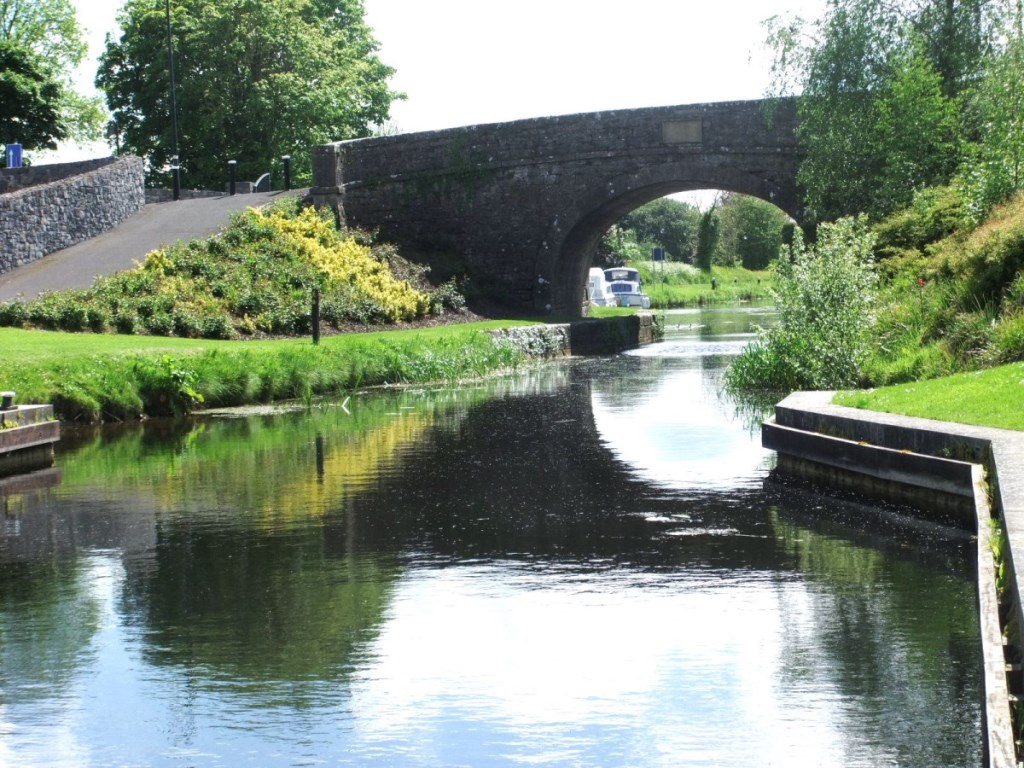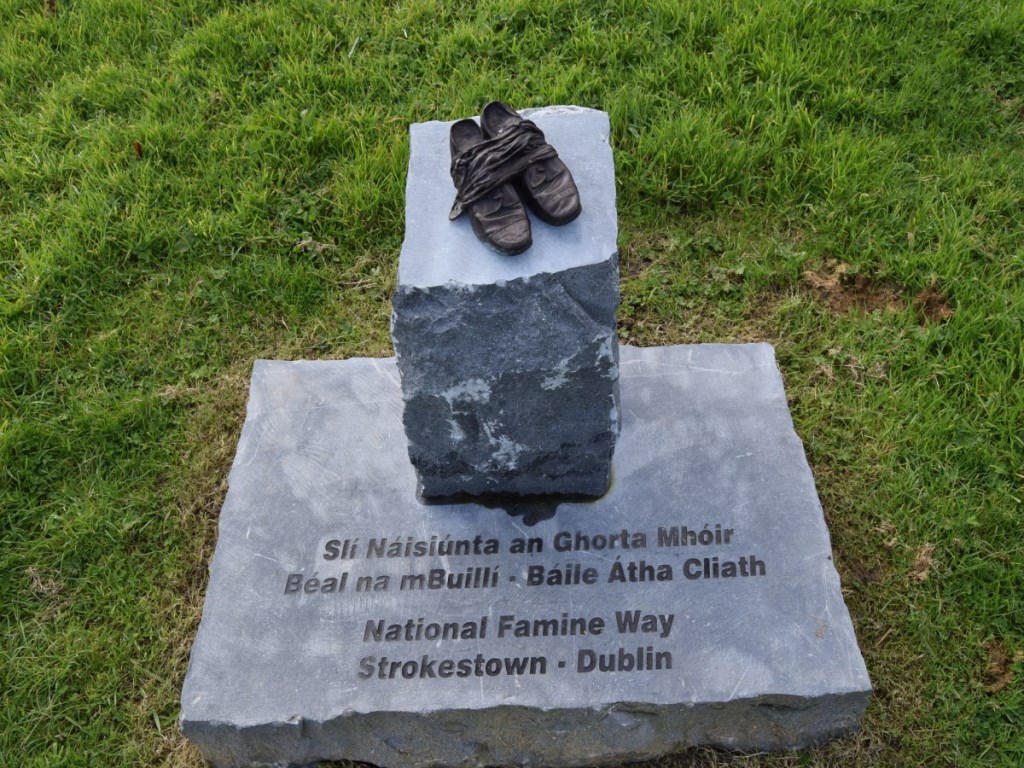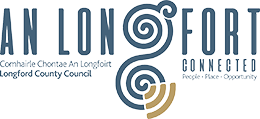Royal Canal

The Royal Canal at Abbeyshrule
The Royal Canal (Irish: An Chanáil Ríoga) is a canal originally built for freight and passenger transportation from Dublin to Longford in Ireland. It is one of two canals from Dublin to the River Shannon and was built in direct competition to the Grand Canal. The canal fell into disrepair in the late 20th century, but much of it has since been restored for navigation. The length of the canal to the River Shannon was reopened on 1 October 2010, but a final spur branch, to Longford Town, remains closed.
The canal passes through Maynooth, Kilcock, Enfield, Mullingar and enters County Longford 2.4km on the Westmeath side of Abbeyshrule. It menders from the County boundery through the Whitworth Aquaduct, Abbeyshule, Ballybrannigan Harbour, Ballymahon, Keenagh, Killashee and finishes at Richmond Harbour in Cloondara. It also has a spur to Longford. The total length of the main navigation is 145 kilometres (90 mi), and the system has 46 locks. There is one main feeder (from Lough Owel), which enters the canal at Mullingar.
In 1755, Thomas Williams and John Cooley made a survey to find a suitable route for a man-made waterway across north Leinster from Dublin to the Shannon. They originally planned to use a series of rivers and lakes, including the Boyne, Blackwater, Deel, Yellow, Camlin and Inny and Lough Derravaragh. A disgruntled director of the Grand Canal Company sought support to build a canal from Dublin to Cloondara, on the Shannon in West County Longford.
Work on this massive project commenced in May 1790 at Cross Guns Bridge, Phibsborough in a westerly direction towards Ashtown. This is commemorated in the plaque beneath the keystone of Ranalagh Bridge. Twenty seven years later, in 1817, the canal reached the Shannon.[1] The total cost of construction was £1,421,954.[2] Building was unexpectedly expensive and the project was riven with problems; in 1794 the Royal Canal Company was declared bankrupt. The Duke of Leinster, a board member, insisted that the new waterway take in his local town of Maynooth. The builders had to deviate from the planned route and necessitated the construction of a 'deep sinking' between Blanchardstown and Clonsilla. The diversion also called for the building of the Ryewater Aqueduct, at Leixlip.
In 200 years it has been maintained by eight successive agencies: the Royal Canal Company, the Commissioners of Inland Navigation, the New Royal Canal Company, Midland Great Western Railway Company, Great Southern Railways, CIÉ, and (from 1986) the Office of Public Works.
During the Famine, “the missing 1,490” starving tenants of Denis Mahon in Strokestown House, Roscommon, set out on foot from the estate in May 1847. Major Mahon had offered them the choice of emigration through “assisted passage”, starvation on their blighted potato patch farms or a place in the terrifying local workhouse. These families weakened by starvation walked for days along the towpaths of the Royal Canal to Dublin, where they were put on boats to Liverpool, and from there to Quebec aboard four “coffin ships” – cargo ships, ironically loaded with grain from Ireland, and unsuitable for passengers. It is estimated that half died before reaching Grosse Île in Canada. It was the largest single disposal of inconvenient tenants during the Famine. Major Mahon was shot dead that November after news had got back to Roscommon about the fate of his former tenants. The new National Famine Way trail takes in the arduous and faithful walk the desperate and poor who made the journey.

Bronze shoes on the Royal Canal at Mosstown Harbour, Longford representing all who walked from Strokestown to Dublin during the Famine (The National Famine Way)
By the 1830s the canal carried 80,000 tons of freight and 40,000 passengers a year. In 1845 the canal was bought by the Midland Great Western Railway Company. They considered draining the canal and building a new railway along its bed but decided instead to build the railway beside the canal. The two run side by side from Dublin to Mullingar. Competition from the railways gradually eroded the canal's business and by the 1880s annual tonnage was down to about 30,000 and the passenger traffic had all but disappeared.
It had a brief resurgence during World War II, when horses and barges returned to the canal. CIÉ took over the canal in 1944. As rail and road traffic increased, the canal fell into disuse. In 1974, volunteers from the Inland Waterways Association of Ireland formed the Royal Canal Amenity Group to save the canal. By 1990 they had 74 kilometres of canal, from the 12th lock in Blanchardstown to Mullingar, open again for navigation. In 2000, the canal was taken over by Waterways Ireland, a cross-border body charged with administering Ireland's inland navigations. In October 2010, the whole length of the canal was formally reopened.
Today Waterways Ireland is responsible for the canal, and it was under their stewardship, in association with the Royal Canal Amenity Group, that the Royal Canal was officially reopened from Dublin to the Shannon on 2 October 2010. Access points currently exist along the whole route of the Royal Canal to Cloondara in Co Longford. In 2006, a commemoration marker was erected at Piper's Boreen, Mullingar, to mark the 200 years since the canal reached Mullingar in 1806.
The Royal Canal Greenway
The Royal Canal Greenway is a 144-kilometre (89-mile) long-distance trail that follows the towpath of the canal from Ashtown, Dublin to Clondra, County Longford. It is typically completed in three days. It is designated as a National Waymarked Trail by the National Trails Office of the Irish Sports Council and is managed by Waterways Ireland. In 2015, Dublin City Council began extending the walking and cycling route along the Royal Canal from Ashtown to Sheriff Street Upper. The Royal Canal Way connects with the Westmeath Way west of Mullingar, and will eventually form the eastern end of the Dublin-Galway Greenway, the final part of EuroVelo Route 2, a cycling path from Moscow across Europe to Galway.
Useful links: Waterways Ireland, Sport Ireland, Royal Canal Amenity Group, Blueways Ireland - Royal Canal, The Royal Canal Greenway




